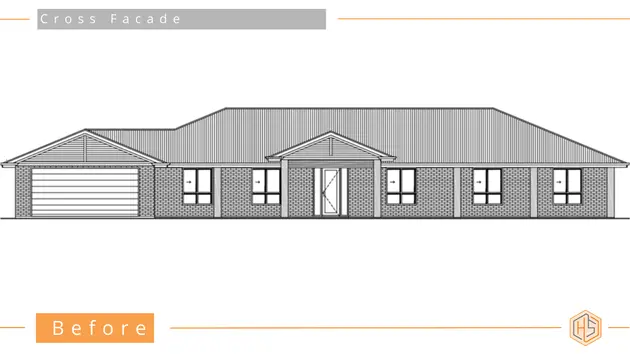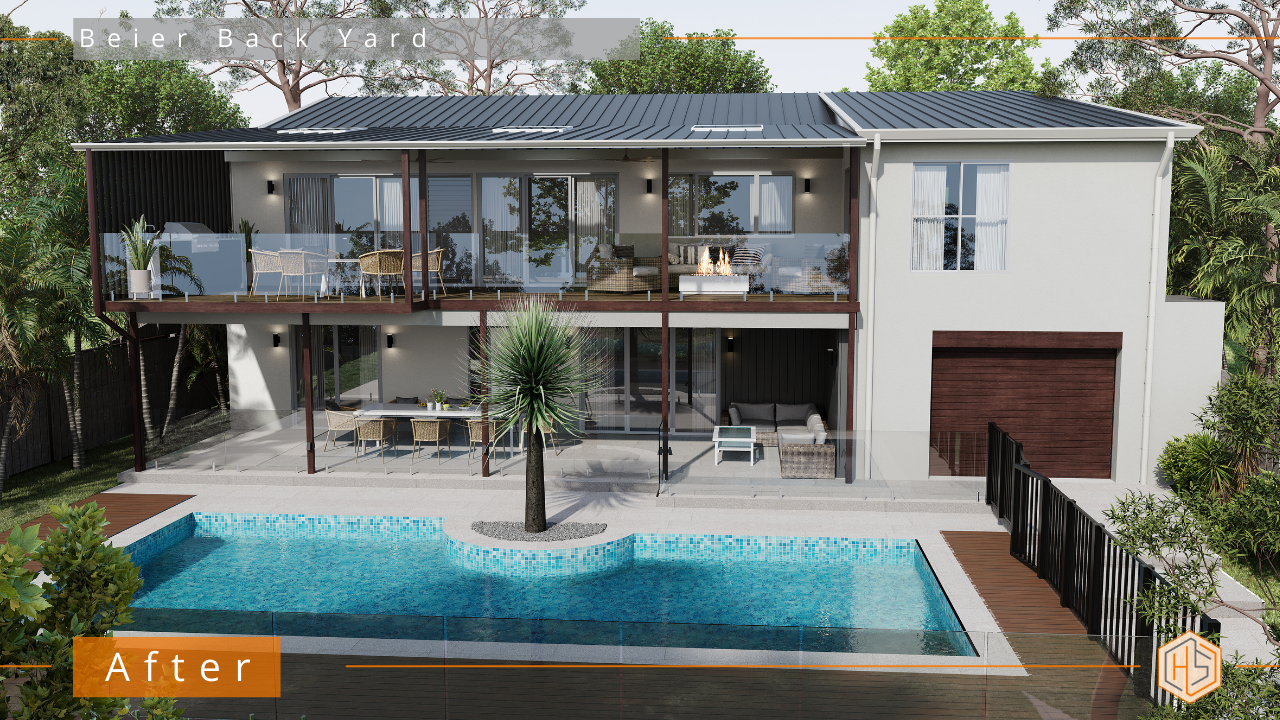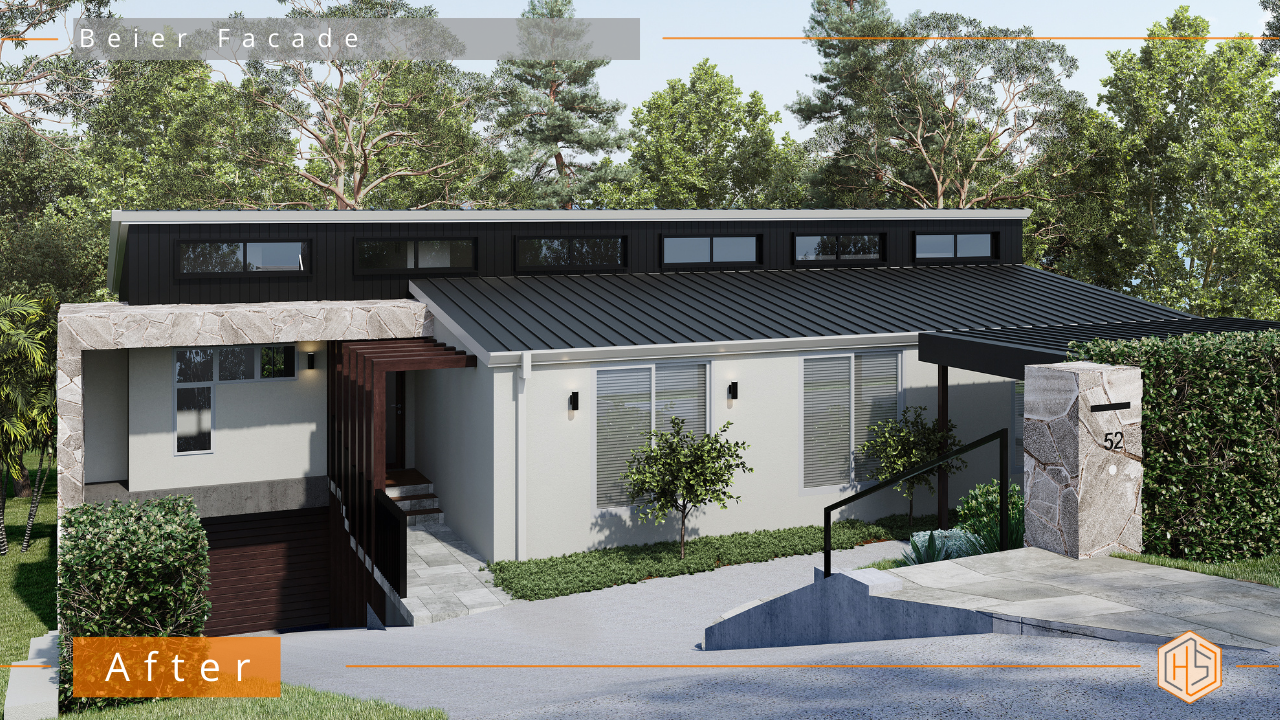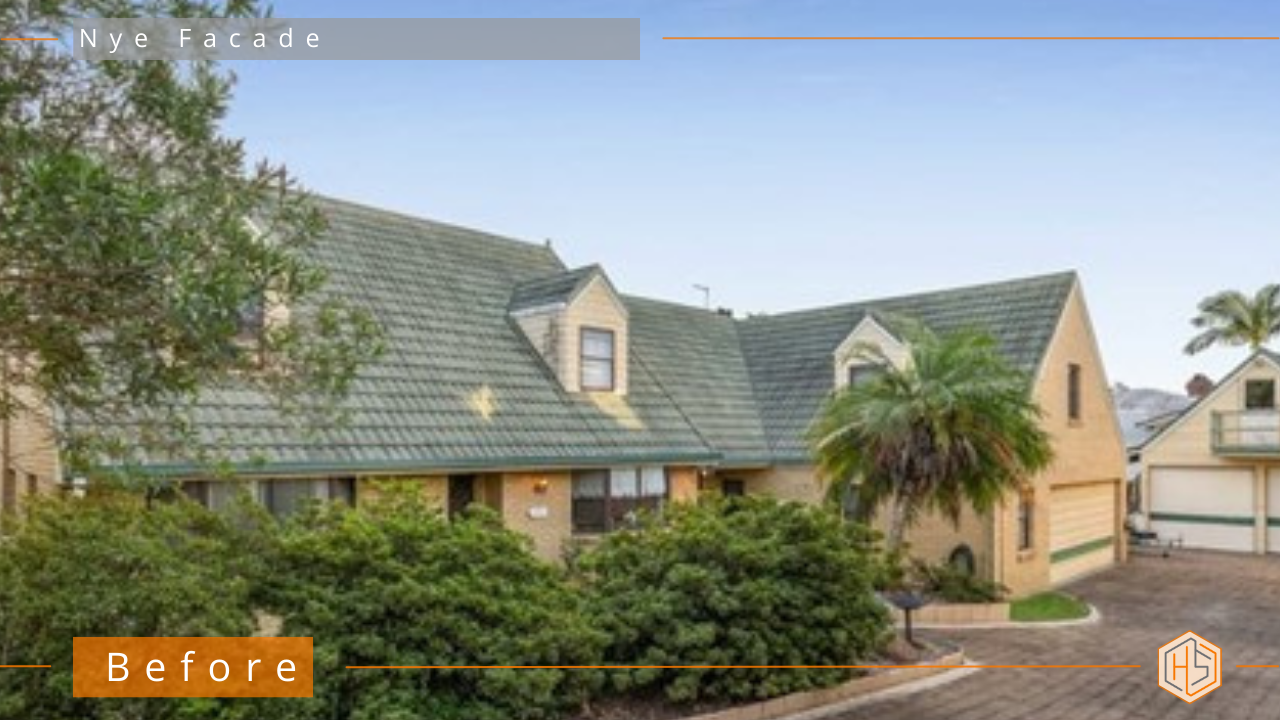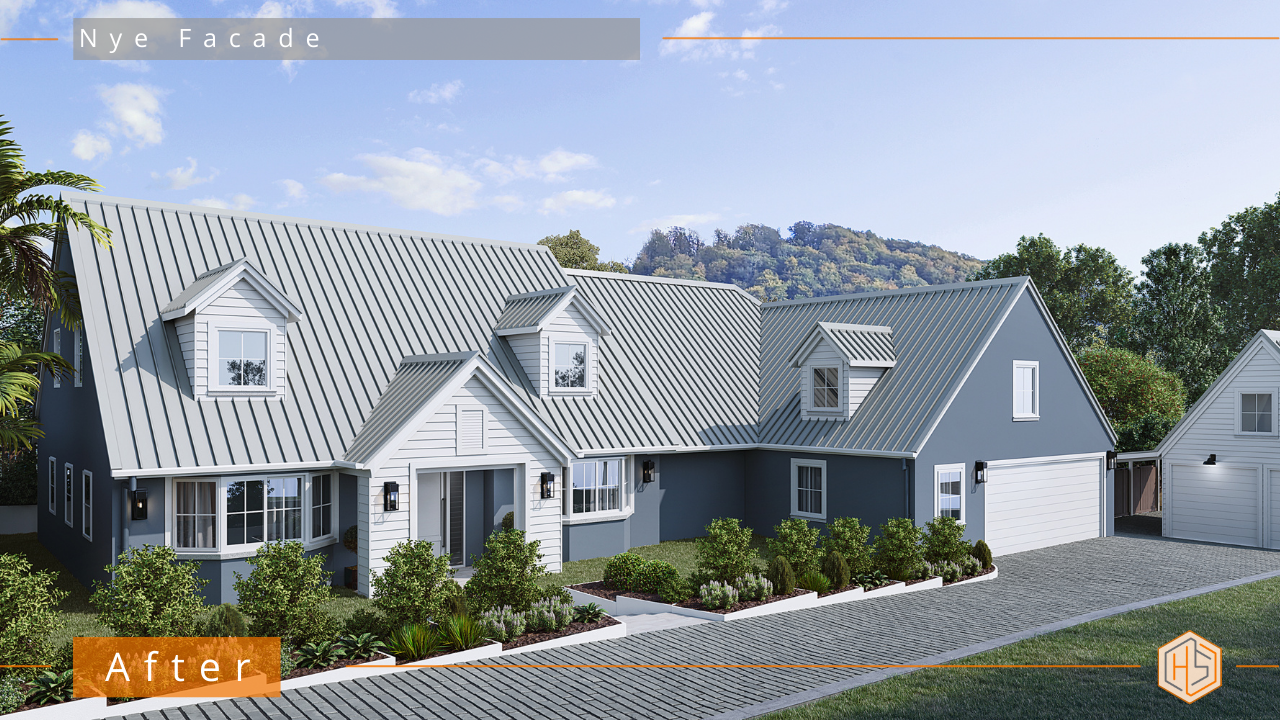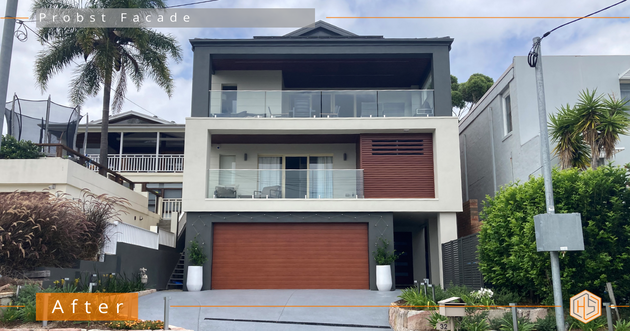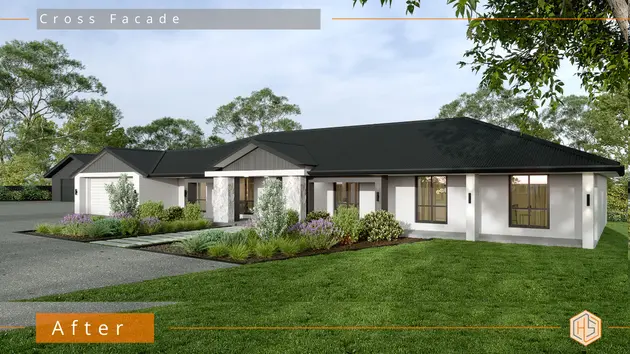
When it comes to facade renovation design, achieving a harmonious and visually appealing exterior can feel overwhelming. So, to simplify the process, I often rely on my trusted Rule of Five and Three.
This formula is all about balancing five colours and three textures—including both new and existing elements—to create a cohesive and striking design.
Let me break it down for you.
What is the Rule of Five and Three?
– Five Colours: These include your primary and secondary colours, as well as accent shades. Think of it as your home’s colour palette that ties everything together.
– Three Textures: This refers to materials that add depth and dimension to your facade, such as stone, render, or cladding.
👇👇Designed by Hotspace👇👇
A Real-Life Example:
Above is a recent project I worked on—a new build in South Australia. Here’s how the Rule of Five and Three came to life:
Five Colours:
>> Monument for the windows.
>> A light white-grey for the walls.
>> A mid-grey on the gables and arches.
>> Stone on the front pillars.
>> Black for the lighting and garden edging.
Note: The roof colour had already been chosen by the client (Monument). While darker roofs may not suit every location due to heat concerns, it was a perfect fit for this South Australian home.
Three Textures:
>> Stone for the pillars.
>> Render on the walls.
>> Cladding to add architectural interest.
This blend of materials creates depth and visual interest, elevating the overall design.
The Jewellery:
No home is complete without the finishing touches, so we added lighting and landscaping as a kind of “jewellery”. In this project, carefully chosen black lighting fixtures and sleek garden edging added polish to the design.
Why This Rule Works in Facade Renovation Design
The Rule of Five and Three ensures your home doesn’t feel flat or one-dimensional. The balance of colours and textures creates depth, while the “jewellery” finishes the look beautifully. It’s a straightforward approach that ensures every detail is cohesive and intentional.
Transform Your Facade with My Help
Whether you’re building new or refreshing an older property, I’d love to help you bring your vision to life. My expertise in facade renovation design ensures your home’s exterior will stand out and reflect your personal style. Let’s work together to create a facade that turns heads for all the right reasons!
Get in touch today by clicking the link below.
Jane
https://hotspaceconsultants.com/preliminary-enquiry/
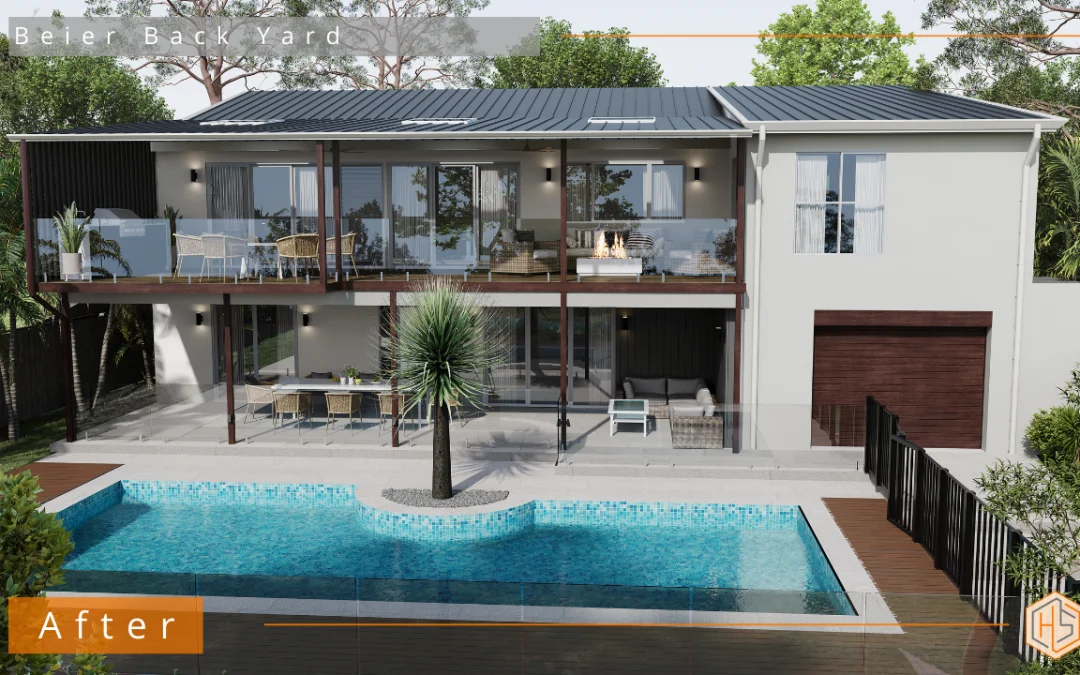
As we move into the warmer months of Summer, many homeowners find themselves exploring outdoor living ideas and dreaming of an update. It’s the perfect time to create a space where you can relax, entertain, and make the most of those long, sunny days. But while colours and aesthetics are often the first things people focus on, practicality is just as crucial to creating an outdoor area you’ll love and use consistently.
I recently redesigned this home in Terrigal, NSW, and it reminded me how often practicality is overlooked. Here are some outdoor living ideas to balance beauty and functionality in your space.
👇👇Designed by Hotspace👇👇
Privacy Matters – If privacy is a concern, think about incorporating solutions like decorative screens or lush landscaping. These elements can create a secluded oasis while enhancing the visual appeal of your space. For example, adding layered planting or timber screens not only blocks views but also introduces texture and depth to your design.
Keep Natural Light in Mind – If your renovation involves a new roof, be aware that it could make your indoor living spaces darker by cutting out natural light. This can be particularly noticeable if the outdoor area is directly adjacent to your home. Skylights are a fantastic way to mitigate this issue, flooding your interiors with light and ensuring your home remains bright and inviting.
Plan for Maintenance – Outdoor areas that face north or west often endure harsh sunlight, which can wear down materials faster. Choosing durable, low-maintenance options like composite decking or aluminium fencing can save you countless hours of upkeep. While these materials may have a higher upfront cost, their longevity and ease of care often make them worth the investment.
Think About Use and Comfort – Before making design decisions, take a moment to consider how and when you’ll use your outdoor area. Will it be a space for morning coffee, afternoon play with the kids, or evening dinners with friends? Your answers should guide your choices, from the layout to the materials. Also, consider external factors like wind, sun exposure, and neighbouring properties to ensure your outdoor area is both comfortable and functional.
Designing for Long-Term Enjoyment – An outdoor space isn’t just an extension of your home—it’s a place to create lasting memories. Prioritising both aesthetics and practicality ensures that your investment will bring joy for years to come. By thoughtfully addressing privacy, light, maintenance, and usability, you’ll create a space that’s not only beautiful but also works for your family’s needs.
So as you plan your next outdoor living project, remember: a little forethought goes a long way. Enjoy the process and the beautiful results that follow. Happy Summer!
Jane
https://hotspaceconsultants.com/preliminary-enquiry/
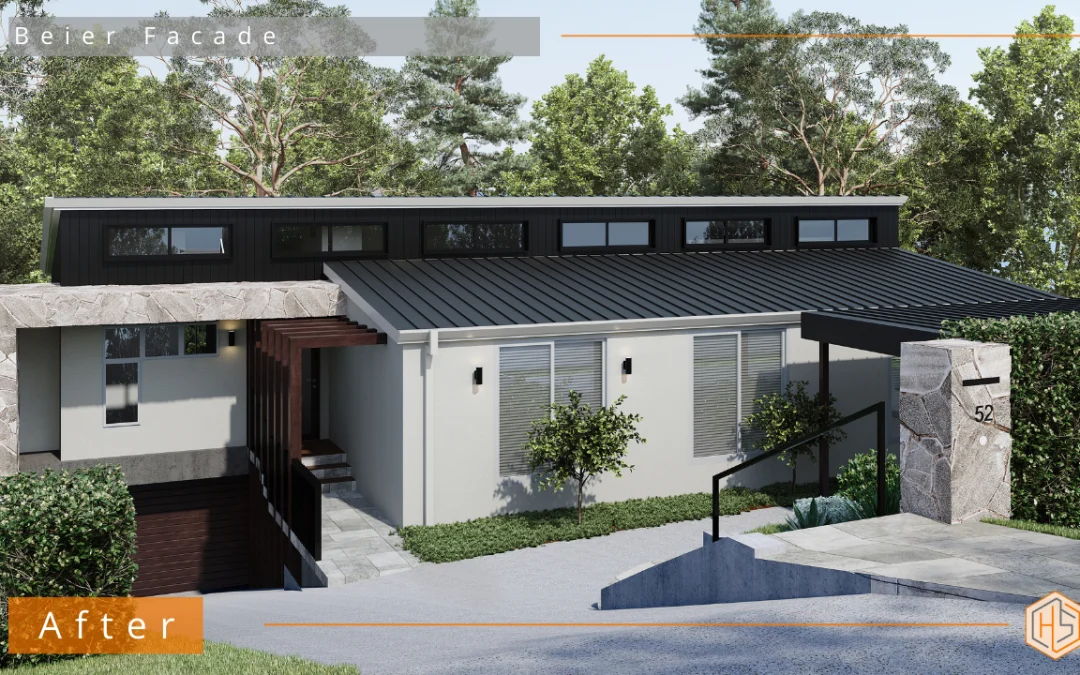
Choosing the perfect colour combination for house exterior design is essential for a striking and cohesive look. One of my favourite palettes—and one that clients adore—is a white or light-coloured render paired with timber or timber-look features, natural stone, and black or charcoal accents. This timeless blend brings together warmth, texture, and sophistication, making it a highly desirable choice for modern and classic homes alike.
👇👇Designed by Hotspace👇👇
Recently, I redesigned a house exterior 👆👆 that perfectly exemplifies how this combination of colours and materials can elevate a property’s curb appeal. The house’s brick walls were rendered in a crisp, light tone to create a clean and neutral canvas. We then introduced stunning timber arches at the front entrance, adding warmth and a sense of natural beauty. To further enhance the facade, we incorporated a larger stone-clad feature area, which was mirrored in the mailbox design to tie the entire look together seamlessly.
Adding Depth with Details – No exterior design is complete without its “jewellery.” For this project, pops of charcoal were used for the lighting fixtures and mailbox numbers, creating subtle yet striking contrasts against the light render. Beautiful greenery was also strategically placed to soften the overall appearance. These finishing touches ensure that the design remains inviting and harmonious, despite its clean and minimalist aesthetic.
The Importance of Textures and Materials – This colour combination highlights a key principle in exterior design: when rendering a facade, you must introduce additional colours and textures to prevent the look from becoming flat and sterile. Imagine this home’s facade with only render and no complementary features like stone or timber. It would lack depth, interest, and character.
By combining materials such as natural stone and timber or timber-look finishes, you create a layered, visually engaging design that feels balanced and polished. These elements not only add texture but also contribute to the overall durability and value of the home.
Why does this colour combination for house exterior renovations work so well?
– White or Light-Coloured Render: Creates a fresh, neutral backdrop that allows other elements to stand out.
– Timber or Timber-Look Features: Adds warmth, natural beauty, and a sense of modernity.
– Natural Stone: Introduces texture and an organic feel, grounding the design.
– Black or Charcoal Accents: Provides contrast and sophistication, tying the design together.
– Greenery: Softens the overall look and enhances curb appeal.
Inspiration for Your Own Exterior – If you’re considering a home makeover or building a new property, this colour palette could be the perfect choice for you. Remember to think about how the elements work together—from the render and timber features to the stone and accents. By carefully selecting and balancing these materials, you’ll create an exterior that is both timeless and unique.
Are you ready to transform your home with a stunning colour combination? Contact me below to discuss how I can bring your vision to life!
Jane
https://hotspaceconsultants.com/preliminary-enquiry/
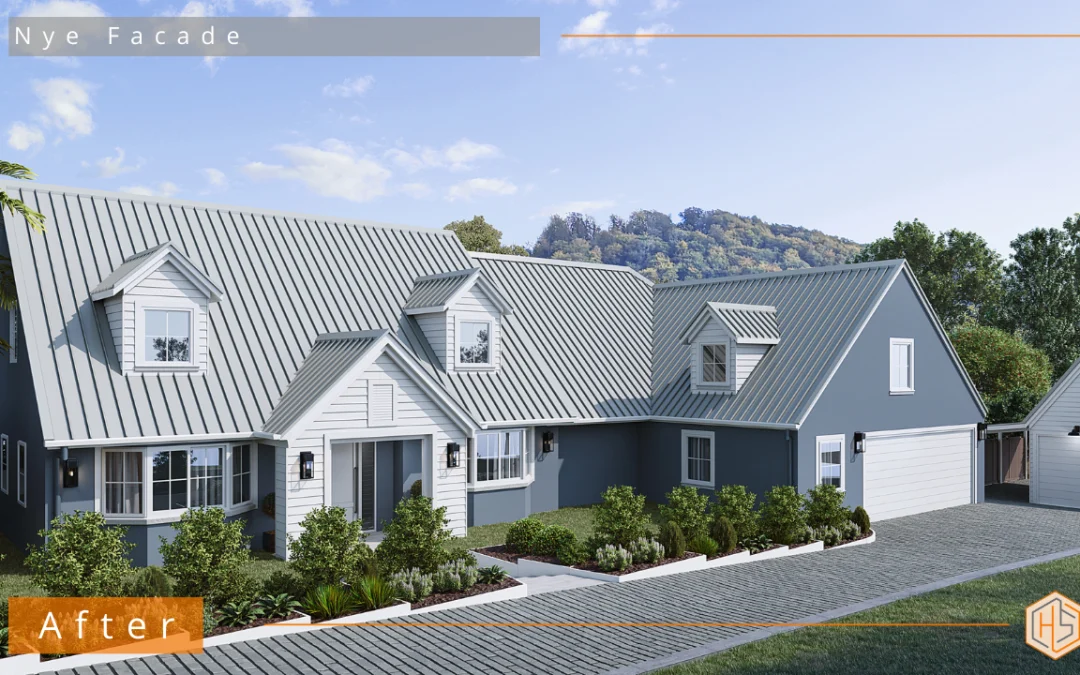
When giving your home a facelift, it’s easy to feel overwhelmed by the endless renovation style options available. So how do you narrow them down to ensure they suit your home?
Start With Your Roofline – Your roofline holds the secret to unlocking your home’s potential. This structural feature sets the boundaries of what renovation styles will naturally fit your home and what might feel out of place.
While you might be drawn to the clean lines of a contemporary style or the charm of a country cottage, not every house will suit every style.
👇👇Designed by Hotspace👇👇
For this 👆👆 recent project I designed in Brisbane, I could have steered toward French Country, Georgian, or even Tudor Revival. Instead, I went with a modern Cape Cod look, drawing directly from my client’s inspiration board, which was filled with images of Hamptons, Cottage, and Cape Cod styles.
Creating Harmony With Your Home’s Story – When you’re planning a renovation, remember that unity is key. You want all parts of your property to feel like they belong to the same family. This means that even if you have multiple buildings on-site, your design choices should reflect a common style and colour scheme to avoid a mismatched appearance.
Choosing Cape Cod for this featured project was more than just picking a style out of a hat—it was about creating a harmonious look across the property. The Cape Cod style’s clean lines and coastal charm aligned seamlessly with my client’s vision, creating a balanced blend of old and new. We rendered and repainted the main house and added a new front entrance portico, which added depth and structure. The barn on the property also received a makeover, so both buildings now share a cohesive look, avoiding that “add-on” feel where one structure feels like an afterthought.
Working With (and Sometimes Against) Your Roofline – In most cases, working with your existing roof shape will save time, money, and sanity. Minor adjustments, like a new gable, a portico addition, or even subtle tweaks to roof height, can make a dramatic difference without requiring a complete overhaul. But if you’re open to more extensive changes, adjusting the roofline can completely transform the feel of your home, allowing you to achieve styles previously out of reach.
When Inspiration Meets Practicality – If your heart is set on a specific style, don’t hesitate to consult with an expert. Exterior design professionals (like Hotspace) can help you navigate your vision within the structural confines of your existing home. While Pinterest, AI and inspiration boards are great for forming initial ideas, not every feature or style will work for every home, especially without significant changes.
Adding Personality With Minor Touches – Don’t underestimate the power of small details. Simple elements, such as rendering, repainting, and updating the entrance, can shift the overall feel of your home. Look to the features that stand out in your favorite styles—and bring those into your design strategically.
Ultimately, when choosing a renovation style, aim to enhance what’s already there while introducing elements that resonate with your personal taste. By drawing from your home’s original character and making thoughtful style choices, you can create a stunning transformation that feels both fresh and authentic.
Jane
https://hotspaceconsultants.com/preliminary-enquiry/

A new house addition or extension can have a hugely positive effect on your home. But there’s a catch: if you don’t carefully plan the design, the new addition can stick out like a sore thumb, clashing with the existing look of your home. To create a cohesive and appealing home exterior, here are some essential tips to keep in mind.
👇👇Designed by Hotspace👇👇
Synchronize Your House Addition with an Exterior Update – Ideally, you’ll want to tackle both the existing exterior renovation and the new addition at the same time. Doing them together allows you to blend both seamlessly, making the new structure look as though it’s always been part of the house. When these projects are coordinated, your home gains a polished, intentional look that enhances kerb appeal.
The Power of Colour and Style – The colours and materials you choose will be key to achieving a cohesive design. Think carefully about how they’ll interact with your existing home. The style and vibe of your house addition also need to align with the architectural character of your home; whether that’s traditional, modern, or something in between. When done right, a well-blended addition can complement and even elevate the overall appearance of your house.
Project Spotlight: A Seamless Addition in Sydney – To give you a clearer idea, here’s an example from a project I recently completed in Sydney. The clients wanted to add an ensuite to the first level of their large brick home, located on the right-hand side, while also modernising the exterior. With a vision for a sleek, contemporary vibe, I opted for a blocky, picture-frame design to enhance their facade while incorporating the new ensuite.
Layering Colours and Materials for Balance – For a balanced look, I matched the colour of the cladding on the new ensuite with the garage door. This visual connection creates a sense of harmony across the facade. To reduce the imposing look of the brick, I layered materials thoughtfully: a lighter colour was “sandwiched” between two darker tones. This layering effect softened the overall appearance and added a sense of depth to the facade.
The result? The new design feels more balanced, welcoming, and less overpowering. By carefully selecting colours and using layered materials for the existing facade and house addition, I was able to give the home a cohesive look that feels modern and intentional.
Key Takeaways for Your Own Project
– Plan Simultaneously: Renovate your exterior and do your new house addition at the same time to make blending easier.
– Consider Colour Harmony: Match or compliment colours and materials between the new addition and existing elements.
– Layer Materials for Depth: Use a mix of light and dark colours to avoid an overbearing appearance.
– Respect the Architectural Style: Ensure the addition’s design complements the original style of your home.
With careful planning and thoughtful design, you can achieve a new house addition that enhances rather than disrupts your home’s kerb appeal.
I hope that helps if you are planning an extension or addition to the front of your home!
Jane
https://hotspaceconsultants.com/preliminary-enquiry/
Finding the best tradespeople can be one of the most important decisions you make in your renovation journey. Whether it’s ensuring a professional finish or keeping the project on budget and on time, hiring qualified, reliable tradespeople is essential. Here’s a guide to finding and hiring the best tradespeople, with tips for each step of the way.
1. Start with Recommendations – Word of mouth is often the most reliable way to find trusted tradespeople. Here’s how to make the most of personal recommendations:
– Ask at specialty shops: If you’re looking for a specific type of tradesperson, check with businesses in that field. For example, ask at a tile shop if you need a tiler, or at a paint shop if you need a painter. These suppliers often have connections with skilled tradespeople who know how to handle their materials well.
– Talk to friends, family, and neighbours: Reach out to anyone you know who’s recently completed a renovation. People who’ve been through it will give you honest feedback about their experiences, both good and bad.
Getting recommendations from reliable sources can give you a list of tradespeople with proven track records and ensure a level of confidence in the quality of their work.
2. Use Trusted Online Platforms – If you’re having trouble finding personal recommendations or want a larger pool of options, online platforms are a great way to source and vet tradespeople. In Australia, websites like Hipages and Airtasker connect you with tradespeople, giving you a snapshot of their qualifications, experience, and reviews from past clients. Here’s how to use these tools effectively:
– Look at reviews and ratings: Previous clients’ feedback is invaluable. The best tradespeople will have a high rating and numerous positive reviews.
– Read profiles carefully: Many platforms allow tradespeople to list their qualifications, specialties, and past projects. Compare profiles to find someone with experience suited to your specific needs.
– Check for relevant certifications: Online platforms often verify qualifications, but it’s still a good idea to double-check any licensing, especially for regulated fields like electrical or plumbing work.
3. Leverage Local Facebook Groups and Community Boards – Local social media groups and community boards are fantastic resources for finding tradespeople that come highly recommended by people in your area. Many homeowners post their experiences, and you can even find reviews on who not to hire, which can be equally valuable!
– Join local renovation and home improvement groups: Many communities have Facebook groups dedicated to sharing recommendations and feedback on tradespeople.
– Check out community boards and forums: Apps like Nextdoor or local notice boards often feature posts about tradespeople in the area, making it easier to find someone close by and familiar with local codes and standards.
These local resources act as community-driven review sites, giving you access to tried-and-tested tradespeople nearby.
4. Confirm Qualifications and Insurance – Once you have a shortlist of potential tradespeople, it’s essential to confirm their qualifications and insurance coverage. Here’s what to check for:
– Licensing and certifications: For trades like plumbing, electrical work, and structural construction, licensing is a must. Ask to see copies of any relevant certifications to confirm they’re up to date.
– Insurance coverage: Ensure that each tradesperson has liability insurance. This protects you financially in case of property damage or injury while they’re working on your project.
Working with fully licensed and insured professionals isn’t just about compliance; it’s peace of mind that the job will be done right and that you’re protected from liability if anything goes wrong.
5. Get Multiple Quotes and Compare – It’s tempting to go with the first tradesperson who seems to fit, but it’s always a good idea to gather several quotes to compare costs, qualifications, and timelines. Here’s how to make the most of the quote-gathering process:
– Be specific about the job scope: Provide each tradesperson with the same detailed description of the project, including materials, expected timelines, and any other relevant details. This will ensure that each quote is comparable.
– Request itemized quotes: Ask each tradesperson to break down their quote into material and labour costs. This level of transparency can help you see exactly where your money will go and avoid hidden fees.
– Look for balance, not just the lowest price: Avoid selecting a tradesperson solely on price. An unusually low quote can sometimes mean hidden costs or poor-quality materials. Look for someone who balances quality, experience, and affordability.
6. Set Clear Expectations and Create a Contract – Once you’ve selected a tradesperson, it’s essential to establish clear expectations and protect yourself with a formal agreement. A written contract is essential for major renovations and even helpful for smaller jobs. Here’s what to include:
– Scope of work: Outline exactly what’s expected of the tradesperson and any details about the project. This can help prevent misunderstandings or scope creep.
– Payment milestones: Rather than paying the full amount upfront, set up a payment schedule based on project milestones. This keeps the tradesperson incentivized to stay on track.
– Timeline and deadlines: Set a clear project timeline with expected completion dates for each phase. Agree on what will happen if the project runs over schedule or if unexpected costs arise.
7. Tips for Working Smoothly with Tradespeople – To ensure a smooth working relationship with your tradespeople, communication is key. Here are some tips for effective collaboration:
– Stay in regular contact: Daily or weekly check-ins (depending on the project scope) can keep you updated on progress and help resolve any issues quickly.
– Respect their expertise: While it’s essential to communicate your vision, trust the tradesperson’s experience. Often, they’ll have valuable insights on the best materials or techniques.
– Be flexible but clear: Flexibility is vital during renovations, but make sure your tradespeople know when they need to check in with you on any changes.
Hiring the right tradespeople can make or break your renovation project. By gathering recommendations, using trusted online resources, checking qualifications, and managing quotes carefully, you’re setting yourself up for a smooth, cost-effective renovation. The time you invest in finding the best people for the job will pay off in quality results—and a finished project you can be proud of.
Jane Eyles-Bennett
https://hotspaceconsultants.com/preliminary-enquiry/


